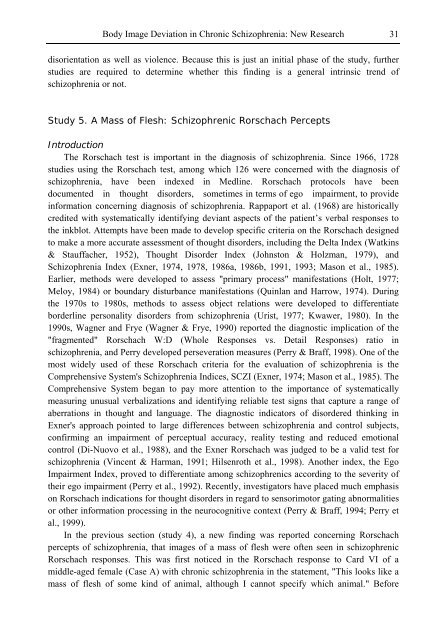Schizophrenia Research Trends
Schizophrenia Research Trends
Schizophrenia Research Trends
- No tags were found...
You also want an ePaper? Increase the reach of your titles
YUMPU automatically turns print PDFs into web optimized ePapers that Google loves.
Body Image Deviation in Chronic <strong>Schizophrenia</strong>: New <strong>Research</strong> 31disorientation as well as violence. Because this is just an initial phase of the study, furtherstudies are required to determine whether this finding is a general intrinsic trend ofschizophrenia or not.Study 5. A Mass of Flesh: Schizophrenic Rorschach PerceptsIntroductionThe Rorschach test is important in the diagnosis of schizophrenia. Since 1966, 1728studies using the Rorschach test, among which 126 were concerned with the diagnosis ofschizophrenia, have been indexed in Medline. Rorschach protocols have beendocumented in thought disorders, sometimes in terms of ego impairment, to provideinformation concerning diagnosis of schizophrenia. Rappaport et al. (1968) are historicallycredited with systematically identifying deviant aspects of the patient’s verbal responses tothe inkblot. Attempts have been made to develop specific criteria on the Rorschach designedto make a more accurate assessment of thought disorders, including the Delta Index (Watkins& Stauffacher, 1952), Thought Disorder Index (Johnston & Holzman, 1979), and<strong>Schizophrenia</strong> Index (Exner, 1974, 1978, 1986a, 1986b, 1991, 1993; Mason et al., 1985).Earlier, methods were developed to assess "primary process" manifestations (Holt, 1977;Meloy, 1984) or boundary disturbance manifestations (Quinlan and Harrow, 1974). Duringthe 1970s to 1980s, methods to assess object relations were developed to differentiateborderline personality disorders from schizophrenia (Urist, 1977; Kwawer, 1980). In the1990s, Wagner and Frye (Wagner & Frye, 1990) reported the diagnostic implication of the"fragmented" Rorschach W:D (Whole Responses vs. Detail Responses) ratio inschizophrenia, and Perry developed perseveration measures (Perry & Braff, 1998). One of themost widely used of these Rorschach criteria for the evaluation of schizophrenia is theComprehensive System's <strong>Schizophrenia</strong> Indices, SCZI (Exner, 1974; Mason et al., 1985). TheComprehensive System began to pay more attention to the importance of systematicallymeasuring unusual verbalizations and identifying reliable test signs that capture a range ofaberrations in thought and language. The diagnostic indicators of disordered thinking inExner's approach pointed to large differences between schizophrenia and control subjects,confirming an impairment of perceptual accuracy, reality testing and reduced emotionalcontrol (Di-Nuovo et al., 1988), and the Exner Rorschach was judged to be a valid test forschizophrenia (Vincent & Harman, 1991; Hilsenroth et al., 1998). Another index, the EgoImpairment Index, proved to differentiate among schizophrenics according to the severity oftheir ego impairment (Perry et al., 1992). Recently, investigators have placed much emphasison Rorschach indications for thought disorders in regard to sensorimotor gating abnormalitiesor other information processing in the neurocognitive context (Perry & Braff, 1994; Perry etal., 1999).In the previous section (study 4), a new finding was reported concerning Rorschachpercepts of schizophrenia, that images of a mass of flesh were often seen in schizophrenicRorschach responses. This was first noticed in the Rorschach response to Card VI of amiddle-aged female (Case A) with chronic schizophrenia in the statement, "This looks like amass of flesh of some kind of animal, although I cannot specify which animal." Before
















